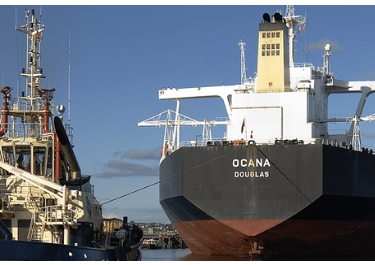As featured in the Port's newsletter, OnBoard, December 2016.
 The fleet of leviathan harbour tugs run by Svitzer out of Pembroke Dock is critical to keeping Britain’s energy moving.
The fleet of leviathan harbour tugs run by Svitzer out of Pembroke Dock is critical to keeping Britain’s energy moving.
The very first time men managed to fit a power plant on a boat they lashed a rope to its back end and set it to work. It was 1803 and Scottish engineer William Symington had perfected the world’s first successful steamboat, the Charlotte Dundas. Having shown her mettle, she was instantly drafted in to pull two heavy barges full of coal down the Forth and Clyde Canal. She managed only two miles per hour but she mightily impressed onlookers; no other barge would make the trip into strong headwinds that day.
Tug boats have developed to be an essential team player in the world of shipping. They range in size from the Charlotte’s descendants, that pull barges up and down rivers and canals, to the vast sea going salvage tugs that harness oil rigs and stricken ships.
In the Milford Haven Waterway, a very special fleet of so-called harbour tugs is used. These are tremendous beasts with three vital roles: Firstly, they are ship handlers. They pull and push clumsy tankers in busy, confined waters and nudge them safely onto jetties. Secondly they act as escorts, on hand and able to intervene if any ship loses power or steerage. Thirdly, they are firefighters. Vast pumps on-board can lay down an overwhelming amount of water via nozzles fitted high on the tugs’ superstructure.
“When the plans to create LNG terminals were tabled, we were tasked with a very specific set of roles,” explains Svitzer’s port manager at Milford Haven, Keith Furlong. “The terminal operators put safety at the heart of their plans, so we had the world’s most powerful fleet of harbour tugs constructed to be able to deliver the service they demanded.”
At only quarter of a kilometre long and 56,000 gross tonnes the tanker, Thornbury, is not the biggest ship to come in. At the helm is Steve Kerrison. Steve joined the tugs in this port when he was 16 (his father was a fisherman out of Milford). His tug Caldey is on escort duty and has been tethered via a thick towing line onto the tanker whilst out at sea. The tug follows the tanker like an obedient dog at heel of its master. The day is calm and, but for a rumble beneath the spotless deck, there is nothing to hint at the raw power available at Steve’s helm, should he require it.
“We follow her in in escort mode for now,” explains Steve. The mismatched pair head in through the west channel. “The rules say if she’s not attached, she’s not coming in.”
As they head into the more confined space of the port they gather up Svitzer Ramsey, Caldey’s twin sister. A thump reverberates through the tug as the huge winch drum on deck kicks into life. The oil tanker is being reeled in and slowed and so the relationship between ship and tug changes. Obedient companion becomes caretaker. As they close in to the jetty, Ramsey is also tethered to the Thornbury and the two tugs begin the coordinated berthing procedure.
“Easy way to stern, two,” comes the request to Caldey from the pilot onboard the Thornbury. Steve swivels the twin controls and the giant propellers beneath the tug begin hauling back and slowing the tanker to a halt. Again not a hint of the effort, bar the turbulent, eddying white waters that churn from under Caldey’s hull.
Then Ramsey and Caldey shoulder gently up against the ship, like herdsmen leaning against the flank of a stubborn cow. Steve responds to precise instructions from the bridge of the tanker and the behemoth Thornbury inches as slowly as 2cm per second onto the jetty.
"All stop." instructs the pilot and the Thornbury is made fast. Job done.
Please follow the link to find out more about Svitzer.


